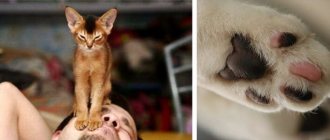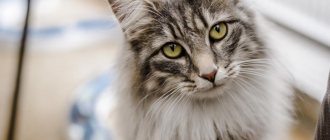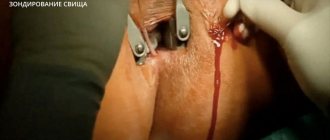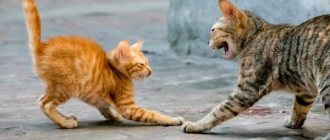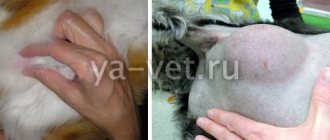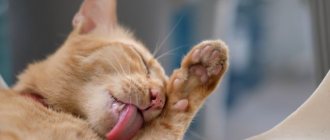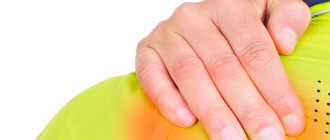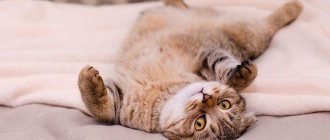The article was finalized and certified
Dubovitsky Yuri Igorevich
Veterinarian
Ask a Question
Some owners begin to sound the alarm if their beloved pets suddenly have a sagging belly. In fact, a hanging belly is not always considered a serious sign of any disease. For example, a fat pouch on the abdomen is characteristic of the Scottish Fold cat breed. But in some situations, unfortunately, there is cause for concern. Let's look at the reasons why the skin sometimes hangs on the stomach of pets.
What is a cat's fat tail?
A cat's fat tail is scientifically called a “primordial pouch,” which means a genetic tendency in some cat breeds to form a fold of skin on the abdomen, between the hind legs.
A small hanging tail is considered normal for cats if it is elastic, soft to the touch, does not cause pain and its size does not exceed 5 cm.
In felinology, there are several theories that explain this anatomical feature in cats:
- The inguinal skin fold is a “depot” for fat deposits, which are consumed during prolonged fasting of a cat, which allows animals to survive in the most difficult circumstances. Fat deposits in cats are especially noticeable during the winter cold.
- The fat tail acts as a repository of excess elastic skin, which is actively used when jumping high, long, while climbing trees or when entering narrow crevices, when the cat needs to stretch out “in line” to get to the desired place.
- A hanging belly in cats is an additional means of protecting internal organs during fights and fights with relatives. Cats tend to deliver powerful blows to the enemy with their hind legs, and an additional layer of skin will protect the vulnerable belly from damage to internal organs.
All domestic and wild cats have a fat tail, but in some it is more pronounced due to breed or physiological characteristics, in others it is less pronounced.
In spring and summer, the size of the saggy tummy in cats is significantly reduced, and in late autumn and winter the fat tail grows again.
When a cat's hanging belly is a dangerous symptom
Unfortunately, a hanging belly may well be a sign of some serious illness. We list the main dangerous reasons that lead to the problem of sagging belly:
- Worms
- if an adult or a kitten has a hanging belly, vomiting, constipation or diarrhea, bad breath, itching in the anus, then you can suspect that the whole problem lies in the worms that inhabit the intestines and stomach. With such a parasitic infestation, the cat’s entire body often looks literally exhausted (regardless of whether the animal’s appetite is good or bad), but the stomach hangs and swells like a ball due to the presence of a large number of worms in the digestive organs, which produce gases as a result of fermentation. - Oncology of the gastrointestinal tract
- malignant neoplasms, as a rule, develop against the background of unfavorable heredity, low immunity, poor nutrition, and hormonal disorders. A bloated, hanging belly can be caused by tumors of the stomach, intestines, liver or other abdominal organs. The main signs of oncology are a sharp loss of body weight (in this case, the abdomen of an emaciated cat literally looks like a ball), diarrhea and vomiting (blood and mucus may be present in the stool, the color and smell of the masses often become unusual), pain and rumbling in the abdomen, fever, unpleasant smell from the mouth; - Infectious peritonitis
- when an animal is infected with feline coronavirus and its mutation in FIP, inflammation of the peritoneum develops, which leads to ascites and sagging of the abdomen, refusal to eat, fever, problems with the liver and kidneys, convulsions, problems with coordination and breathing. Unfortunately, when this diagnosis is confirmed by special research methods, the prognosis is fatal; - Ascites
- abdominal dropsy is not considered an independent disease, it is just a symptom of some serious ailments: peritoneal injuries, oncological processes, renal failure, heart and lung diseases, the above-mentioned viral peritonitis and other infections introduced into the body, for example, even after abdominal surgery . The fluid that accumulates inside the abdominal cavity literally pulls the cat's belly down. Other sure signs of ascites in cats are nausea and vomiting, stool disorders, breathing problems, rapid pulse, pallor or yellowness of the mucous membranes (if the cause of the disease is directly related to the liver); - Mastitis
- it is believed that the mammary glands usually become inflamed in pregnant and lactating cats, but a similar illness can also occur in a nulliparous cat, for example, due to infection of the nipples as a result of injury, or the use of hormonal drugs to suppress ovulation in the cat. Signs of mastitis are hot and swollen hard nipples (which gives the impression that the cat has a bag hanging in the lower abdomen), pain, discharge of pus or blood from the nipples (often along with milk if the pet is nursing), increased body temperature; - Pyometra
- purulent inflammation of the inner lining of the uterus often develops in cats after abdominal surgery, when an infection has been introduced into the body, against the background of hormonal imbalances and various problems of the genitourinary system. The main signs of pyometra, in addition to an enlarged and sagging abdomen, are debilitating diarrhea and vomiting, thirst, fever, vaginal discharge with an unpleasant odor, pain in the peritoneum, refusal to eat, apathy; - Inguinal or umbilical hernia
are congenital hereditary or acquired pathologies consisting of damage or stretching of muscle tissue or serous membranes, resulting in internal organs protruding through them (a similar problem can occur, for example, in small kittens and dogs, as a complication after sterilization, after childbirth, injuries, etc.). The main sign of a hernia in a cat is a noticeable soft (or hard) formation in the abdominal area, which usually easily hides inside when pressed; - Problems with delivery
- sometimes a cat’s belly hangs immediately after birth, when frozen fetuses remain inside the womb. In this case, the pet’s belly will be quite hard, since the unborn kitten can be felt by palpation. Other signs of frozen pregnancy are cramping pain in the peritoneum and bloody-purulent vaginal discharge that lasts more than a week after delivery; - Cushing's syndrome
- a violation of the production of the hormone cortisol, which is produced by the adrenal glands, leads to multiple problems in addition to an increase in abdominal volume: loss of appetite (the cat eats often and a lot), thirst, weight loss (despite an excellent appetite), frequent urination, deterioration of the skin, seizures , problems with bones (the animal’s skeleton becomes quite fragile).
Physiological reasons for the appearance of folds
A skin fold in the groin area usually appears in adult cats that lead a very active lifestyle, as well as after giving birth, while feeding kittens, or during weight loss.
Kittens of hybrid breeds (who have wild and native cats in their family) have a fat tail from a young age and this is considered the norm.
To the touch, the fat tail of a healthy cat or kitten looks like an oblong soft fold of skin in the groin area, inside of which there is a small deposit of homogeneous fatty tissue (without compactions or nodules).
The skin in this area should be thin, mobile, warm, and not cause discomfort to the pet during palpation and stroking.
Treatment methods
Treatment procedures are aimed at relieving symptoms and eliminating the cause of the pathology. Therapy is carried out only by a veterinarian who, after diagnosis, will give a number of recommendations. Treatment:
- Worm infestation. The doctor prescribes drugs to remove helminths. The choice depends on the type of parasite. Forms of medicines: sugar cubes, tablets (Kaniquantel, Drontal, Milbemax, Trontsil, Pratel), Prazicide suspensions, Profender drops. The course of treatment will be explained by the veterinarian.
- Constipation and obstruction. Procedures: thinning enemas, gastric lavage with menthol or ichthyol solutions, abdominal massage. Elimination of pain - analgin subcutaneously. Mucous decoctions, laxatives, and vegetable oils are given internally.
- Abscess. The pet's condition deteriorates sharply, so treatment is ineffective. With timely treatment, the pet’s health will be in the hands of the doctor.
- Peritonitis. Usually leads to death. If you go to the clinic in a timely manner, you can save the animal. Usually the doctor prescribes antibiotics, abdominal puncture, and painkillers. Hormone therapy is carried out and vitamins are given.
- Injury. Surgery is performed to stop the bleeding, and procedures are prescribed to replenish the blood.
- Biliary colic. Therapy depends on the cause that caused such a symptom.
We invite you to read: Demodicosis in cats: symptoms and treatment
If a cat has a swollen belly, what should the owner do at home:
- palpate gently. The stomach should not be rock-hard, and touching should not cause painful sensations in the animal;
- remember what the pet ate and what medications the pet took over the past 3 days.
If the animal remains active, can go to the toilet without problems and does not experience problems with bowel movements, it does not need to be taken to the clinic right away. However, in the following days, it is necessary to closely monitor the general condition of the cat and the degree of bloating in its abdomen.
Important! When a cat has a bloated stomach, many owners try to help and give a massage, but this is prohibited. If the cause is inflammation or fluid effusion, massaging the tummy will greatly aggravate the condition.
Nutrition correction
A bloated belly in a domestic cat can be treated with proper nutrition. The number and size of servings is calculated by the veterinarian based on the weight and age of the animal.
If your pet eats ready-made food, you should pay attention to options for cats with gastrointestinal diseases or sensitive intestines
Cats eating homemade food need to include boiled or baked vegetables (zucchini, peppers, tomatoes), fat-free meat and plenty of fresh water in their diet. You can add dietary supplements with natural fiber, which normalizes the functioning of the digestive organs.
Note! If your pet has a habit of eating food, you need to block access to the trash can and hide all food from the table. If the cat’s condition is severe, it will require a drainage system, which will be installed at the veterinary clinic.
Drainage tubes are inserted into the abdominal cavity and excess fluid or blood is removed through them. The system is installed for several days. As a result, the amount of liquid collected per day should not exceed 50-100 ml. After this, the drainage is removed
If the condition is severe, the cat will need a drainage system, which is installed at the veterinary clinic. Drainage tubes are inserted into the abdominal cavity and excess fluid or blood is removed through them. The system is installed for several days. As a result, the amount of liquid collected per day should not exceed 50-100 ml. After this, the drainage is removed.
Surgery
Internal bleeding, tumors and tears can be corrected with surgery. The sooner the owner consults a doctor, the easier it is to prevent the consequences of the disease.
Surgery is required as a last resort
Abdominal bloating in a domestic cat is not always a sign of illness. If the stomach is swollen for the first time, it is soft and touching does not cause pain in the cat, the cause may be improper nutrition or swallowing air. Symptoms such as general weakness, vomiting and diarrhea, a hard and hot stomach are dangerous and indicate an aggravated pathology. In this case, you should immediately take the cat to a veterinarian for examination.
Breed characteristics
Some cat breeds are characterized by the obligatory presence of a fat tail (a genetically determined trait), these include:
| Cat breed | Phenotype feature |
| Hairless cats | No fur |
| Sphinx (Canadian, Egyptian) | Straight ears |
| Bambino | Shortened paws |
| Elf | Ears turned back |
| Ukrainian Levkoy | The tips of the ears are rounded inward |
| Cohona | Round ears, many folds |
| Peterbald | Large long ears, narrow muzzle (like Orientals) |
| Britons or British Shorthair cats ("blue blood") | Flat muzzle, voluminous cheeks, predominantly yellow eyes, short harsh coat, plush appearance, deep gray color |
| Scottish cats: Scottish Fold (low-eared) and Scottish Straight (straight-eared) | Flat muzzle, soft short fur of various colors, predominantly yellow eyes, ears may be straight, partially flattened or lying on the head |
| Savannah | Large spotted cat, hybrid with wild breeds |
| Chausie (housey) | Large (up to 15 kg) wild-colored cats with thick, dense, short hair |
| Cornish Rex | Short wavy coat |
| Bengal cat | Complexly colored spotted fur (leopard-like) |
| Kanaani | Tassels on large ears, spotted color |
The breeds listed above also have some characteristics. For example, the Scots: not all representatives have a hanging belly, but only the European line (and this feature is clearly noticeable in small kittens).
Bambino cats
Elf cat
Peterbald cat
British cat
Scottish cat
Chausie cat
Bengal cat
Among the Canadian Sphynxes, the appearance of a pronounced belly after castration of cats is considered the norm, which adds some charm to them and touches the owners.
Important! Hairless breed cats require special care for skin folds throughout the body (wipe with wet wipes) due to the increased oiliness of the skin.
All British cats have a hanging belly from an early age and this should not frighten new owners. A fold of fat between the hind legs is not a flaw in the appearance of show animals; experts do not pay attention to it at shows. Even in British cats of thin build, the fat tail stands out clearly.
How to tell if your cat is obese
Most healthy domestic cats weigh between 4 and 5 kg as adults, although there is significant variation. Some large breeds, such as Maine Coons or Norwegian Forest cats, can weigh up to 6-7 kg and still remain healthy and not obese, while smaller breeds, such as the Abyssinian or Siamese, can weigh around 3 kg .
To assess physique, the more important point is not body weight, but external indicators.
During examination, the owner can be guided by the following symptoms of weight gain:
● In an obese cat, it is difficult to feel the ribs and spinal column, as they are covered with a thick layer of fat.
● All bony protrusions are smoothed out.
● There is no “waist” when viewed from above.
● Significantly sagging belly. Even thin cats have a small tail, this is their specific feature.
Additional symptoms of obesity:
● Shortness of breath.
● Fatigue.
● Lameness.
● Sluggish, lazy gait.
● Low mobility.
Pregnancy and postpartum period
Quite often you can find fat tail in pregnant cats, especially if the fetuses in the uterus are large or there are many of them.
Multiple births are hereditary, highly valued and supported in the breeding of elite cat breeds, so in breeding females, a saggy belly pouch is a desirable feature.
Large fetuses are undesirable for breeding, as this means that the mother cat will have a difficult and protracted labor, and a caesarean section may be required. And then the skin fold may change due to sutures.
The fat tail is even more pronounced in the postpartum period in cats, when stretched skin hangs on the abdomen, which within a few days restores its elasticity and tightens.
Rudimentary sac and fat cat
If you think your cat is fat, it could be a bud - and vice versa. This is the first part of a cat's body to store fat if she gains weight. This will make it look like your cat is gaining excess weight in that area.
© shutterstock
If you're not sure, there are obvious differences between a fetal sac and an overweight cat. Here are some telltale signs:
- Your cat's belly doesn't quiver when it walks because the extra fat keeps the skin taut. A cat with a saggy sac will sway from side to side. The bag contains a minimum of fat.
- If you look at a cat from top to bottom, you won't see the rudimentary pouch because it hangs down from the underside of the abdomen. Instead, the fat will appear round as it fills all sides of your cat's body. A fat cat will look around from all sides, and when you touch its body, it will appear hard. The pouch, on the other hand, appears to be loose skin.
- If your cat is overweight, the ribs will be hidden by fat. To test, stroke your cat's sides to see if you can feel the ribs. If you don't feel it, your pet has gained too much weight. The rudimentary pouch does not hide the cat's ribs.
As described in the US National Library of Medicine, obesity in cats is a common disease that poses a serious problem. A preventative approach to weight loss often produces the best results.
Other factors
It has also been noticed that in older cats (over 10 years old), the collagen fibers in the subcutaneous layer become thinner, the elasticity and turgor of the skin decrease, which is why fat tail appears very often.
Veterinary nutritionists, when prescribing a cat to “lose excess weight,” also often note an increase in the inguinal fold in patients who have lost weight. Especially if the process was intense and was accompanied not only by a transition to dietary nutrition, but also by an increase in exercise.
If the cat has lost a lot of weight and a bag of skin appears in the lower abdomen (while the diet has not changed), then a possible cause may be the progression of chronic diseases (pancreatitis, hepatitis, malignant neoplasms).
Is it normal for a cat to have a saggy belly?
Although there are always exceptions, in most cases, a sagging belly is quite normal for both males and females. There is a scientific reason why cats are built this way! They have been biologically equipped with these pouches for thousands of years, and some of the larger felids, such as the cheetah and lion, have a similar body structure.
Cats have always been hunters, and the primordial pouches are a defense against predators. “Extra skin” protects the internal organs during a dangerous fight.
Another theory from scientists is that the feline has this pouch in case she needs a little extra “space.” We've all witnessed the incredible flexibility of cats at one time or another. One theory is that it is the excess skin that allows them to bend, jump and squirm in the most crazy ways!
Dangerous causes of sagging belly
If your cat has loose skin on his belly and this is causing him anxiety or discomfort, you should contact your veterinarian.
The reasons may be:
- worms;
- frozen pregnancy, fetal death and intoxication;
- intestinal obstruction;
- inflammation of the mammary gland (mastitis);
- injuries (impacts, falls);
- prolapsed hernias after abdominal operations;
- purulent inflammation of the uterus (pyometra);
- cysts, tumors, abscesses, dropsy;
- external parasites (fleas, lice eaters, scabies mites);
- allergies or intolerance to food components;
- stressful state (with the arrival of a new family member, another animal, moving).
Important! All of the above symptoms and diseases require treatment under the supervision of a veterinarian.
Diagnostics
Diagnosis of manifestations involves a number of procedures, such as ultrasound of internal organs.
Even two or three pathological signs should be a reason to immediately take your four-legged friend to see a doctor. During the initial examination, the veterinarian will try to find out the main reasons why the cat’s belly hangs. To determine the diagnosis and prescribe adequate treatment, a referral is given to undergo a number of such diagnostic procedures:
- general clinical analysis of blood and urine;
- biochemistry;
- puncture and histological examination of the contents of the sac;
- Ultrasound of internal organs.

